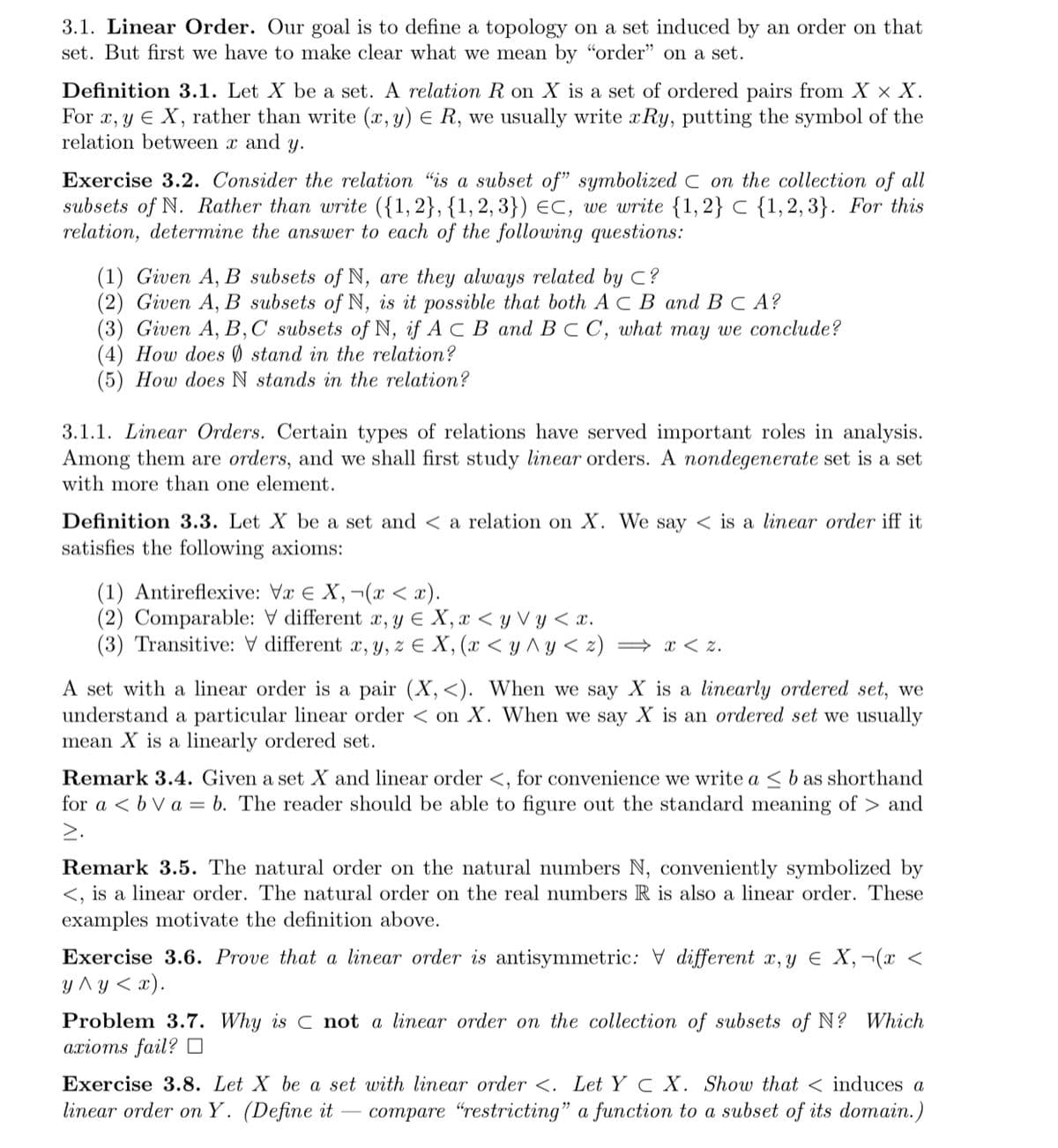Problem 3.7. Why is C not a linear order on the collection of subsets of N? Which axioms fail? O
Problem 3.7. Why is C not a linear order on the collection of subsets of N? Which axioms fail? O
Elements Of Modern Algebra
8th Edition
ISBN:9781285463230
Author:Gilbert, Linda, Jimmie
Publisher:Gilbert, Linda, Jimmie
Chapter1: Fundamentals
Section1.7: Relations
Problem 14E: In each of the following parts, a relation is defined on the set of all human beings. Determine...
Related questions
Concept explainers
Contingency Table
A contingency table can be defined as the visual representation of the relationship between two or more categorical variables that can be evaluated and registered. It is a categorical version of the scatterplot, which is used to investigate the linear relationship between two variables. A contingency table is indeed a type of frequency distribution table that displays two variables at the same time.
Binomial Distribution
Binomial is an algebraic expression of the sum or the difference of two terms. Before knowing about binomial distribution, we must know about the binomial theorem.
Topic Video
Question
Solve problem 3.7 in detail please

Transcribed Image Text:3.1. Linear Order. Our goal is to define a topology on a set induced by an order on that
set. But first we have to make clear what we mean by "order" on a set.
Definition 3.1. Let X be a set. A relation R on X is a set of ordered pairs from X x X.
For x, y E X, rather than write (x, y) E R, we usually write xRy, putting the symbol of the
relation between x and y.
Exercise 3.2. Consider the relation "is a subset of" symbolized C on the collection of all
subsets of N. Rather than write ({1,2}, {1, 2, 3}) eC, we write {1,2} C {1,2, 3}. For this
relation, determine the answer to each of the following questions:
(1) Given A, B subsets of N, are they always related by C?
(2) Given A, B subsets of N, is it possible that both A C B and B C A?
(3) Given A, В,С subsets of N, if A c В аnd B c C, what may we coпcude?
(4) How does Ø stand in the relation?
(5) How does N stands in the relation?
3.1.1. Linear Orders. Certain types of relations have served important roles in analysis.
Among them are orders, and we shall first study linear orders. A nondegenerate set is a set
with more than one element.
Definition 3.3. Let X be a set and < a relation on X. We say < is a linear order iff it
satisfies the following axioms:
(1) Antireflexive: Vx E X,¬(x < x).
(2) Comparable: V different x, y E X, x < y V y < x.
(3) Transitive: V different x, y, z E X, (x < y ^ y < z) → x < z.
A set with a linear order is a pair (X,<). When we say X is a linearly ordered set, we
understand a particular linear order < on X. When we say X is an ordered set we usually
mean X is a linearly ordered set.
Remark 3.4. Given a set X and linear order <, for convenience we write a < b as shorthand
for a < b V a = b. The reader should be able to figure out the standard meaning of > and
>.
Remark 3.5. The natural order on the natural numbers N, conveniently symbolized by
<, is a linear order. The natural order on the real numbers R is also a linear order. These
examples motivate the definition above.
Exercise 3.6. Prove that a linear order is antisymmetric: V different x, y E X,¬(x <
y ^y < x).
Problem 3.7. Why is C not a linear order on the collection of subsets of N? Which
ахiотs fail? ‑
Exercise 3.8. Let X be a set with linear order <. Let Y C X. Show that < induces a
linear order on Y. (Define it
compare "restricting" a function to a subset of its domain.)
Expert Solution
This question has been solved!
Explore an expertly crafted, step-by-step solution for a thorough understanding of key concepts.
This is a popular solution!
Trending now
This is a popular solution!
Step by step
Solved in 4 steps

Knowledge Booster
Learn more about
Need a deep-dive on the concept behind this application? Look no further. Learn more about this topic, advanced-math and related others by exploring similar questions and additional content below.Recommended textbooks for you

Elements Of Modern Algebra
Algebra
ISBN:
9781285463230
Author:
Gilbert, Linda, Jimmie
Publisher:
Cengage Learning,

Elements Of Modern Algebra
Algebra
ISBN:
9781285463230
Author:
Gilbert, Linda, Jimmie
Publisher:
Cengage Learning,